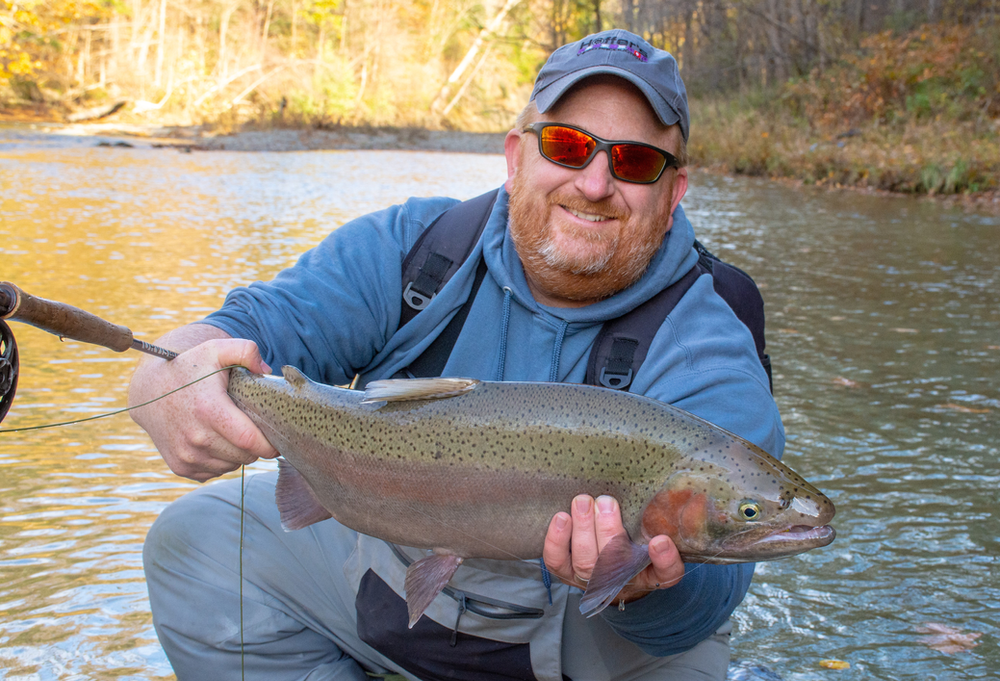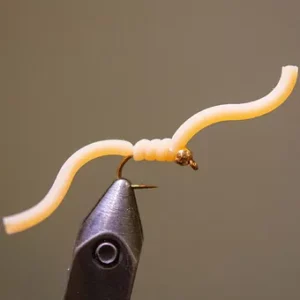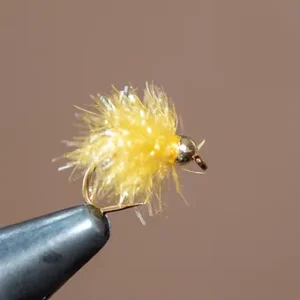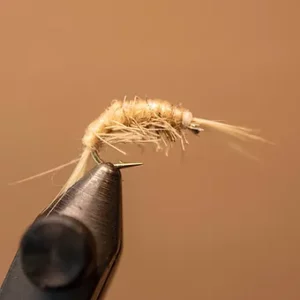Nymphing Techniques for Great Lakes Steelhead

Egg patterns get all the glory for Great Lakes steelhead, but truth is, a variety of nymphs and streamers will also catch fish. Sure, the right egg pattern in the right situation can produce a banner day, but if you focus more on presentation than on trying to find that “magic egg color,” you’ll catch more steelhead no matter what pattern you’re using.
What Steelhead Really Want
Here’s what I’ve learned about steelhead. Like every other fish, they care about presentation. That means putting the fly in front of them on a drag-free drift. Whether it’s a nymph or an egg pattern, the fly has to float through the current in a natural manner.
Steelhead can be as opportunistic as they can selective. Often, what makes them appear selective is that they’re constantly being spooked by anglers. They’re used to being lined, accidentally snagged (although not always accidentally, as you probably know if you’ve spent much time steelhead fishing), and pushed around by anglers carelessly wading into pools. And like any other fish, steelhead simply will not eat when spooked.
Great Lakes steelhead do seem to settle down quicker than other species, though, and are more tolerant of our presence after they’ve been in a tributary for a while. They don’t stay spooked for long. And once settled into a pool or riffle again, they can be pursued the same as any other salmonid with all the same fly patterns.
However, drag will spook fish as quickly as anything. If you’re not presenting the fly in a drag-free manner, you’ll never catch as many steelhead as you could be catching with a natural drift.
Indicator Nymphing
I primarily fish an indicator rig for Great Lakes steelhead. The Erie tributaries on the Pennsylvania side aren’t very high gradient and there are numerous long, slow pools where fish like to stack up. It’s ideal water for fishing an indicator.
My all-round, all-purpose fly rod is a 9-foot, 6-weight Orvis Clearwater. I use a 9-foot, 3x-4x tapered nylon leader. I don’t use fluorocarbon leaders when indicator nymphing because the fluorocarbon will sink, making it more difficult to 1) get a natural drift due to so many currents pulling on it and 2) lift it up off the water for another cast. Nylon leaders ride on the surface. Occasionally I’ll even grease them up with dry fly floatant to make sure they stay on top.
I tie a tippet ring at the end of the leader and a two-foot section of 3x-4x tippet, depending on water clarity. I do use fluorocarbon tippet material because it’s less visible and usually slightly less diameter than matching nylon sizes.
When using an indicator for trout, a two-fly rig is standard. However, you have to be carful about using two-fly rigs for steelhead because fish do tend to group up. Drifting two flies through a bunch of fish is a recipe for snagging one. A snagged steelhead is almost impossible to land on a fly rod, and chances are the fish will just take off and break off anyway.
However, when I find steelhead that are not bunched so close together, two-fly rigs can be deadly, where legal. A two-fly rig allows me to fish two levels. If tying a dropper from the bend of the point fly, use about an 18-inch section of tippet to attach the dropper. I adjust the indicator so that the point fly is close to the bottom but not dragging, and then my dropper is trailing behind and actually bouncing on the bottom
Sometimes, if I come to a pool where numerous fish are suspended, I’ll even adjust the indicator so that the point fly is well up off the bottom, free-floating in the lower third of the water column, and use a longer tippet so that the dropper gets all the way down. Covering these two levels gets the fly in front of as many fish as possible on each drift.
(Disclaimer: make sure it’s legal to fish with more than one fly at a time before you try this. Using two flies in New York, for instance, is strictly forbidden, and they will catch you and fine you for any violation of this law.)
If it’s legal to use two flies at once, I make sure that one of them (usually the point fly) is an egg pattern. I then drop a standard beadhead nymph off the bend of the hook. If I’m using a tag rather than a dropper, I make my point fly a heavier nymph, such as a weighted stonefly, that will bounce along the bottom and then tie in the tag a foot or two above it for an egg pattern.
Does it matter if the positions are changed? Probably not. But this is how I typically do it and it has worked well for me. Either way, fishing two flies at once allows you to experiment more and switch things up and catch an extra couple of fish throughout the course of the day.

Euronymphing and Tight Lining
Euronymphing is an effective method for steelhead, too. I don’t have a Euro rod capable of handling a powerful steelhead, so my version of Euronymphing steelhead is to simply ditch the indicator and tight line the swifter runs and riffles where steelhead are holding. This is especially effective when water levels are up and steelhead are spread more throughout the streams and not just stacked up in deeper pools.
When tight lining, I add an extra split shot above the fly, if necessary, but only enough to get the fly on the bottom and not hang up on every drift. Ideally, I want just enough weight on there to take the slack out of the leader and create a tighter connection between me and the nymphs. Occasionally you can achieve that as you would when Euronymphing for trout in smaller streams, by switching to a larger-sized bead, but that’s not always possible on bigger waters, and that’s when adding the split shot will produce the best results.
The goal of tight lining is basically the same as Euronymphing: maintain contact with your nymphs as they move through the current. You’re guiding the nymphs into the seam where the fish are, and then leading them downstream — not pulling them. The nymphs are essentially free-floating downstream, but you’re keeping the line taut enough that you can still easily detect strikes.
Short and Sweet
Another nymphing technique for Great Lakes steelhead is to keep drifts short and sweet. Don’t worry about covering a lot of water with every pass. Instead, focus on getting drag-free drifts, and the best way to do that is with short, accurate casts.
When indicator nymphing, I constantly mend the line. As soon as my indicator lands on the water, I lift my rod tip and throw as much line as possible upstream, above the indicator. This will allow the fly to free-float through the current without being influenced by the indicator.
Sometimes I tight line with the indicator, too, which means that I hold my rod high enough to keep all of my leader off of the water. Basically, I’m forming a tight line connection with the indicator rather than the fly, but it’s just as effective.
Fly Selection and Changeups
Early in the season, steelhead seem more attracted to shiny things. Many of my favorite patterns incorporate a bead, flashback, or some sort of tinsel to give them a little extra sparkle to catch a steelhead’s attention.
There are probably genetic reasons behind their affinity for flash this time of year, but my guess is that it has just as much to do with their feeding habits once they enter a stream. Basically, they don’t have to eat and can go several months without consistent feeding. Their primary purpose, after all, is propagation of the species. So the flash acts as a trigger, so to speak. It catches their eye and makes them reflexively feed, or perhaps it evokes a territorial response. I’m no expert in steelhead psychology, but I have witnessed this same reaction when fishing for spawning rainbows out West. When nothing else would work, I tied on a scud approximately the same shade of pink as their stripe, and they absolutely annihilated it, not out of hunger, but out of competition.
Later in the season, after the leaves are off the trees, drab-colored nymphs work better for steelhead and I use fewer flies with flash. This is after the run has peaked and fish have experienced heavy pressure for several months. Black, brown, olive, and even purple flies work really well.
Of course, no matter what month it is, I always have a good selection of egg patterns on hand, too. Pink, white, and cheese colored egg patterns will always be in my steelhead box.
The ideal steelhead box is similar to a good trout box, but it doesn’t need quite the variety. However, it should have enough patterns — and different types of patterns — that you can show the fish something completely off the wall once in a while. This is actually one of my keys to catching more fish everywhere and in every situation, not just Great Lakes steelhead.
How many times does each steelhead encounter a fly? Considering how intense the pressure can be on some tributaries, it’s almost impossible to answer that question. It could be hundreds, or it could be thousands. Sometimes I think steelhead get finicky because they see so much of the same stuff over and over again. So when something new comes by — a new pattern or a new color — it triggers them to strike.
Before leaving any pool, whether I’m fishing for steelhead or trout, I always make at least one fly change. It could be to a different colored egg pattern, or a new nymph, or whatever, as long as it looks totally different. Often, this alone will pick up an extra fish or two (or more) that I would not have caught otherwise.
This is where oddball colors absolutely come into play. If you’ve ever wondered why you can buy egg patterns, and even some nymphs, in such a wide variety of colors, many of them far from natural in appearance, this is why. They fill a niche by providing a changeup that can trigger fish to strike simply because they’re totally different from what the fish are used to seeing.
A few years ago, I caught multiple steelhead from one pool that had at least a couple flies stuck in their jaws. I plucked four flies from one particular fish, and all four were different: a Squirmy Wormie, a green Estaz egg, a stonefly nymph, and another drab-colored nymph that I couldn’t quite identify. And that was still fairly early in the season. So much for steelhead being selective!
But my point here is that a variety of flies will catch steelhead. Not just egg patterns. Not just nymphs. Sometimes, in order to get them to hit, you have to show them something completely different that they haven’t seen a hundred times already.

Early Experiences
The first time I ever fished the Erie tribs for steelhead, I was clueless. All I had was my standard box of trout flies and a handful of new egg patterns I’d bought at a local sporting goods store. Two guys were hammering fish one after another, and I overheard one say that chartreuse egg sacs were on fire. The other said he was having luck on orange-colored egg sacs.
A third guy was doing just as well, though. When he was finally ready to leave, he stopped to ask how I was doing.
“Nothing yet,” I said. “I guess don’t have the right color eggs.”
“Nah,” he said, “you don’t need all that fancy stuff. Just tie on a size 16 Pheasant Tail and squeeze into that spot where I was and you’ll do fine. See all these guys here? They’re all catching fish and they’re all using different things.” He then offered a few tips on how to present the fly in that particular spot.
I was 18, by myself, and had nobody else to show me the ropes. I had no internet or social media to consult. I’d simply driven to Erie for the day to see what this steelhead stuff was all about. I took this stranger’s advice and, much to my surprise, I caught fish, not on egg patterns, but on my regular trout nymphs.
Yes, eggs patterns will always be the “standard” in any steelheader’s fly box. Sometimes, egg patterns are all you need, and sometimes fish will prefer them above everything else. Steelhead are fickle creatures, and their preferences often change multiple times throughout the course of the day. One thing remains consistent, though: the right fly delivered with too much drag still won’t catch steelhead.
Great Lakes steelhead aren’t complicated, and fishing for them is really no different than fishing for anything else. Avoid spooking them and show them what they want in a natural manner, and you’ll consistently catch steelhead anywhere. As I found out when I was 18 years old, the technique is more important than the pattern, and a even size 16 Pheasant Tail Nymph will catch a lot of fish when it’s presented the right way!
Did You Find These Nymphing Techniques Helpful?
Stay up to date with the Dark Skies Fly Fishing monthly newsletter for free and receive the latest fly fishing tips, tricks, and techniques from professionals, stream reports, as well as updates on new flies added to the Online Store and exclusive discounts!
Sign Up NowCheck Out The Flies Mentioned In This Post
-
Flies
Squirmy Wormie
Rated 0 out of 5$1.65 Select options This product has multiple variants. The options may be chosen on the product page -
Egg Patterns
Estaz Egg
Rated 0 out of 5$1.65 Select options This product has multiple variants. The options may be chosen on the product page -
Flies
Scud
Rated 0 out of 5$1.35 Select options This product has multiple variants. The options may be chosen on the product page -
Flies
Pheasant Tail Nymph
Rated 0 out of 5$1.65 Select options This product has multiple variants. The options may be chosen on the product page





When I switched to fluorocarbon tippet material, it had nothing to do with visibility or sink rate as I was after abrasion resistance. Since the switch, steelhead break my tippet less often and I replace the tippet less frequently.
Agreed! Fluoro is much more resistant to abrasion. I like it best for Euro/tightline nymphing.
Thanks Ralph,
Get yourself to the Salmon River somewhere between 9/15 and 10/20ish to see “The Show” that is salmon season. It’s quite a spectacle from Pulaski to the hatchery. You may find, as I have, that watching folks fish is more fun than fighting a salmon.
To me, its a stretch to call it fishing. I’m convinced that the vast majority of King’s aren’t eating as they move up the river to spawn. Cohos on the other hand seem a bit more hungry. The end result is a lot of unintentional snagging along with the occasional good fortune of flossing your fly right through their mouth.
Go fight a King and enjoy the rest of the show.
Thank you for your reply and for the suggestion to fish the Salmon River. That’s been on my list of streams to hit for a while now. Hoping this will be the year I get there!
Great article I fish the Salmon River for both Salmon & Steel heads , the Salmon season can get pretty crazy,but I have found most of the fly fishermen are very courteous and if you fish the fly zones you can have a great time hooking into 20/25 lbs salmon, you don’t land too many, but once in awhile you get lucky and land one. The Steel head season is a lot less crowded and if you fish on week days the pressure is a lot less. I have caught a lot of steelheads on a variety of flies, i just purchased the sexy Walt nymphs selection and I am looking forward to trying them out on the river,as soon as the striped bass season is over here in NJ .
I think that’s been part of my hesitation about going to the Salmon River, the crowds and also not knowing exactly where to go. It’s a long day trip for me from north central PA, and I’d hate to waste most of it just trying to find a place to fish. Sounds like the fly zones through the week are the way to go, though. Thanks!
I think you’ll find the Sexy Walts to be quite good at catching steelhead. And if you get a good one, feel free to send a pic! Thank you for supporting this website!
Hi Ralph,
Great article with so many good suggestions! Thanks so much for sharing this information!
Thank you! I really appreciate you reading and taking the time to comment. Best of luck on the water! Ralph
Ralph, great piece and thank you for sharing. There’s an old saying, I can show you better than I can tell you. To that end, it would certainly be helpful if you turned this fine narrative into a YouTube video.
Thank you, Paul, I just might do that! I’m planning to be in Erie more this steelhead season, so stay tuned. Best of luck to you this fall!
Ralph